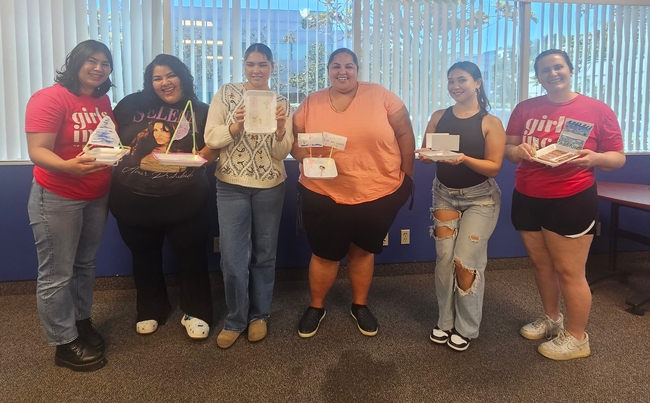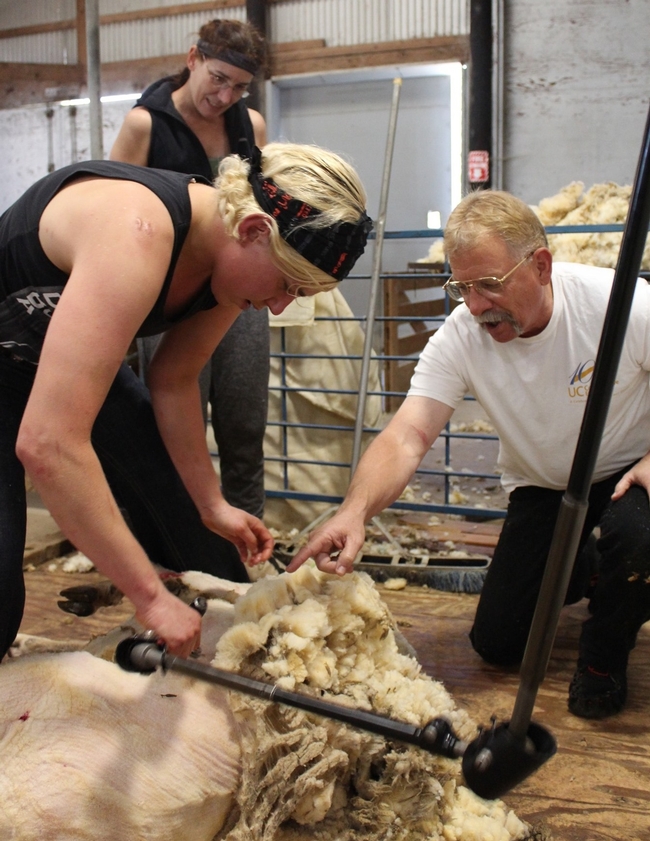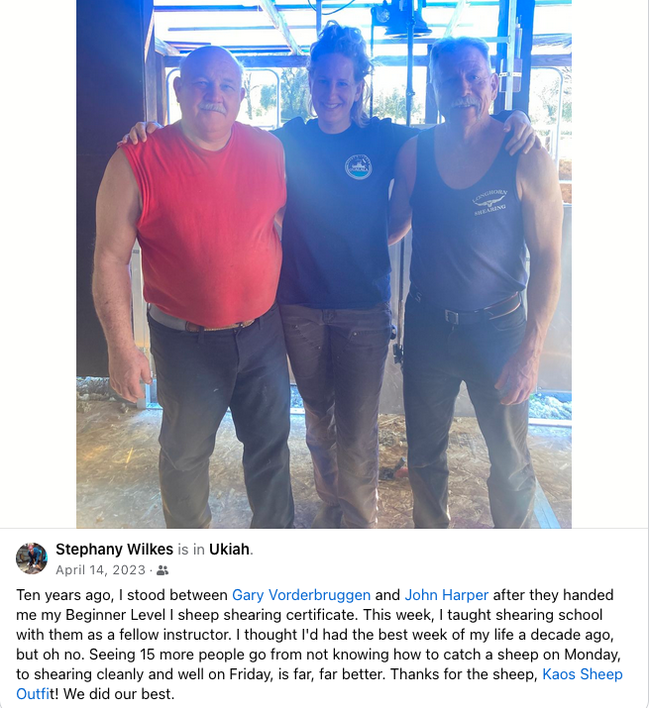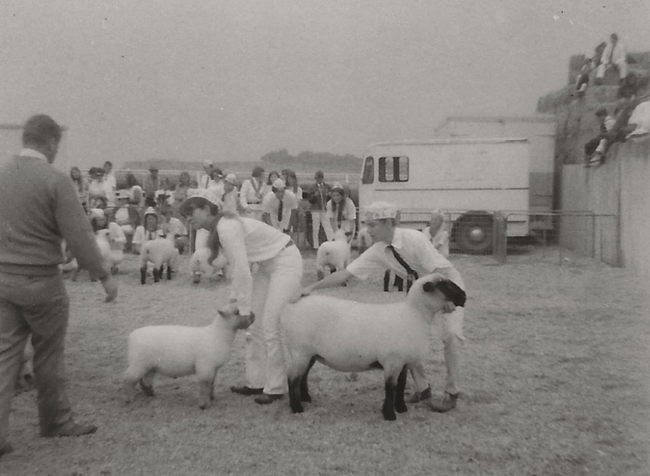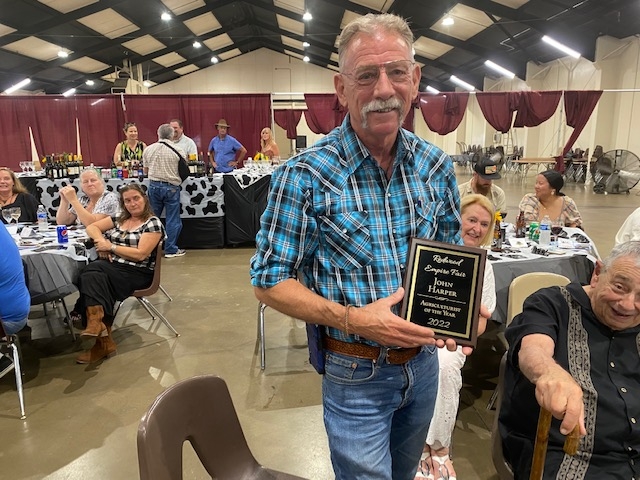Posts Tagged: 4-H
Silver medalist Maddalena reflects on her path from 4-H to Olympics
4-H lessons in discipline, respect, being prepared formed foundation for success in sports, career
Just weeks after winning a silver medal in shooting at the summer Olympics in Paris, France, U.S. Army Staff Sgt. Sagen Maddalena returned to her hometown, where her interest in the sport was sparked as a 4-H member. Groveland, nestled at the entrance of Yosemite National Park in Tuolumne County, greeted her with a hero's welcome on Sept. 21, when she served as grand marshal for the Gold Rush town's annual 49er Day parade.
“Have a dream, think of your future, but put action towards it,” the two-time Olympian advised kids when she spoke at local schools. “I had a dream of going to the Olympics. I continued to work toward it and it came to fruition.”
At an early age, the marksman began focusing on details for a competitive edge. A 4-H volunteer recalled a teenage Maddalena declining a soft drink because she worried that it would affect her shooting performance.
Asked about the memory, Maddalena said that sounded right because sugary drinks may increase one's heart rate, diminishing a shooter's concentration, steadiness and accuracy. She enjoys thinking through the conditions, including wind and light, and winning.
From a small town to the medals podium
Maddalena reflected on her path from participating in California 4-H in Tuolumne County – in a town with a population of 540 – to college, a successful career in the Army and the Olympic medals podium. The 4-H Youth Development Program is delivered by UC Cooperative Extension.
While she doesn't recall how old she was, eight or nine, when she joined the Groveland Highlanders 4-H club, the Tuolumne County native vividly remembers the array of activities.
“I was yay tall,” she said, gesturing with her hand, “and I was cooking cakes in baking classes. I remember my instructor, 4-H leader, Mrs. [Carol] Willmon. We had our meetings up here in Groveland, and I learned a lot about, financials, keeping track of your livestock, how much you're feeding 'em, what money is going in, what money's going out.”
She raised animals to show at the Mother Lode Fair in Tuolumne County – goats, sheep, hogs and horses.
“Me and the sheep weren't very good friends,” she said. “I loved goats; goats and hogs were good. And then I also did fair with horses, showmanship and English and Western [riding styles] with horses. I was all over the map with 4-H, but it really taught me how to take care of my animals.”
But it was a 4-H shooting program that changed her life.
Firearm safety central to first experiences with shooting
“I got started with shooting through 4-H,” said Maddalena, explaining that her parents encouraged her to enroll in a shooting program at age 13. “They wanted to me to learn gun safety and being able to handle a firearm safely if I ever came in contact with one. So that's how I started through 4-H. But with the .22 [firearms] program, I just latched on, I loved it. And there was some competition with it. I learned about safe handling of a firearm, and then I got to compete with it and skyrocketed from there.”
From there, Maddalena joined a junior team, then made her way to the University of Alaska Fairbanks, where she competed in the National Collegiate Athletic Association Rifle Championships. “That really that opened the doors then to possibly going to the Olympics, representing my country on the world stage,” she said.
To hone her shooting skills and serve her country, Maddalena joined the Army. She qualified for the U.S. Olympic team in 2020, competing in Japan during the pandemic, and again in 2024. In Paris, she finished in second place in the women's 50-meter rifle three positions.
“4-H prepared me for the Army really by showing me discipline,” she said. “And it taught me to take care of my equipment or the livestock that I had. So it taught me those life lessons. Discipline, respect and being prepared is what 4-H really brought into my life. Just as a kid, to get that foundation was so important before I moved up and then decided to join the Army.
And then it all came full circle because in the Army it's all about discipline, respect and being prepared.”
Olympian trains soldiers in Army Marksmanship Unit
At 49er Day, youngsters and community members had an opportunity to get some shooting pointers from the silver medalist, who was wearing her Army uniform. For those aspiring to excel in shooting sports, Maddalena, who trains soldiers in marksmanship, had this advice: “Know what's behind your target, have respect for your equipment, go easy on the trigger and always have control of your firearm.”
Maddalena, who has been in the Army for five years, continues to serve as a marksman and an instructor in the U.S. Army Marksmanship Unit.
The secret of success, according to Maddalena, is continuously working toward a goal.
“Have that dream and have that desire,” she said. “But you have to have action towards it. You've got to work toward it. Put in the work to make those dreams come true.”
Maddalena, who is based at Fort Moore in Georgia, continues to hone her skills and aims to compete for gold in the 2028 Summer Olympics in Los Angeles.
“I'm thankful for the opportunity that 4-H gave me in such a small town to be able to be involved with the 4-H program; it really just it helped me grow,” Maddalena said. “And I'm very appreciative of that.”
4-H ag tech breakfast to support next generation of leaders, innovators
Event at FIRA USA in Yolo County includes look at agricultural robotics, automation
The FIRA USA ag tech conference, Oct. 22-24 in Woodland, showcases the latest robotics and automation innovations. A special breakfast during the event will support tomorrow's leaders, scientists and engineers who will realize the potential of those technologies.
Proceeds from the breakfast (Thursday, Oct. 24, 7:30 to 9 a.m. at the Yolo County Fairgrounds) will benefit higher education scholarships for 4-H youth participants interested in applying technology to a wide array of agricultural practices.
During the breakfast, attendees will hear from 4-H alumni – including Glenda Humiston, University of California vice president for agriculture and natural resources – on the impact of their participation in the program.
As a leading nationwide youth-development organization, 4-H delivers research-based, positive youth development practices through its community-based programs. Youth gain life and work readiness skills through hands-on projects. Studies have shown that youth who engage with 4-H programs are more likely to:
- Achieve academically
- Serve in leadership roles in school and community
- Engage in some form of community service
“4-H clubs, project teams and after-school programs develop skills in areas ranging from animal science to robotics, and from natural resources to coding,” said California 4-H Director Kimberly Sinclair Holmes, who will speak at the breakfast. “Scholarships help ensure those seeds of interest and passion blossom into meaningful careers that contribute to agriculture and society.”
Tickets are $100 each and can be purchased at https://bit.ly/4-HFIRAEvent.
The ticket includes all-day access to FIRA USA, touted as “the largest robot playground in the world,” where attendees can get an up-close look at laser weeders, autonomous harvesters, drone applications and a host of other ag tech innovations.
FIRA USA is a collaboration of GOFAR (Global Organization for Agricultural Robotics), Western Growers, UC Agriculture and Natural Resources, and The VINE.
San Diego County goes green for National 4-H Week with proclamation, lighting ceremony
National 4-H Week is Oct. 7-12, 2024. To celebrate, the San Diego County Board of Supervisors will be recognizing the significant benefits to local youth provided by the UC Cooperative Extension 4-H Youth Development Program in San Diego County with a proclamation on Tuesday, Oct. 8. This recognition will take place at 9 a.m. during the board's meeting at the County Administration Center, 1600 Pacific Highway, San Diego, CA 92101.
In California, 4-H is administered through county-based UC Cooperative Extension advisors and educators who provide practical knowledge to people, businesses and communities via science-based research and educational programs. The proclamation not only celebrates 4-H's impact in San Diego County, but also acknowledges the successful partnership between UCCE and the County of San Diego.
As a leading youth-serving organization nationwide, 4-H offers research-based programs that equip young people with life skills, leadership training and community engagement opportunities. It also provides professional development and resources for other youth-serving organizations throughout participating counties, including San Diego.
Liliana Vega, UCCE 4-H youth development advisor for San Diego and Orange counties, envisions her expertise in justice, equity, diversity and inclusion enhancing positive youth development for all, especially Black, indigenous and people of color. Eager to create culturally relevant experiences that resonate with young people, Vega believes that doing so starts with empowering youth-serving professionals with growth opportunities, equipping staff to engage with the community meaningfully and prioritizing diversity.
“By partnering with local organizations, schools and diverse community groups in San Diego, we can elevate the quality and reach of youth programs throughout the county. Together, we can enhance opportunities in STEM, environmental justice, the arts and workforce development for the next generation,” said Vega, while describing the program's collaboration with the YMCA and Girls Inc. in San Diego as excellent examples.
At sunset on Oct. 8, attendees and passersby will witness the County Administration Center lit in the program's iconic green color, symbolizing the organization's century-long commitment to youth development in San Diego County. The proclamation and lighting ceremony are open to the public, and individuals whose lives have been enhanced by 4-H are encouraged to attend.
For more information about UCCE's 4-H program in San Diego County and details on how to get involved, please visit https://ucanr.edu/sites/4HSanDiegoCounty/. You can also contact Rebeca Manzo at remanzo@ucanr.edu or Liliana Vega at live@ucanr.edu.
Barnes brings hometown knowledge to UCCE in Lake, Mendocino counties
New Cooperative Extension director has worked extensively with Native American communities, youth groups
Growing up in Upper Lake, along the “North Shore” of Clear Lake, Matthew Barnes lived near several of the Lake County region's seven federally recognized tribes. Although he counted several Native Americans among his diverse circle of childhood friends, and was very familiar with those communities, Barnes was nonetheless quite nervous when he was appointed in 2009 as the inaugural executive director of the Boys & Girls Club of the Pomo Nation.
Barnes – a non-Native of European and Filipino descent – vividly remembers the tribal administrator paying him a visit on one of his first days on the job. “He said, ‘Hey, you have two ears and one mouth, so listen twice as much as you speak and you'll be fine,'” Barnes recalled. “And that's definitely stuck with me.”
That approach is continuing to guide Barnes in his new role as University of California Cooperative Extension director for Lake and Mendocino counties. He will guide and support research, outreach and education activities to meet the area's agriculture, natural resources, and youth and community development needs.
Since starting in May, Barnes has been getting a crash course from UCCE advisors and staff on viticulture research, pest management practices, 4-H camps, and a host of other projects and programs – while also meeting with local communities on the region's most pressing challenges.
“What I've been doing – and will continue to do – is just to listen and learn, and when I can add value to a conversation or project, then I'll do that,” Barnes said. “But leadership to me starts with the relationships we build – with our staff and with the community.”
Bringing a range of experiences in youth programs, social services
One area in which Barnes will certainly add value is developing youth and community programs. During his time with Boys & Girls Club of the Pomo Nation, it was one of only three Boys & Girls Clubs established on tribal land in California. In that role, Barnes faced the unique challenge of integrating the Boys & Girls Club curriculum into a community for which it was not originally designed.
By adapting the curriculum to include culturally relevant topics, Barnes transformed the program into a model that eventually aided in the creation of a Native American-focused branch, Boys & Girls Clubs of America Native Services.
“This initiative now serves as a national standard for Boys & Girls Clubs on tribal lands,” Barnes said.
He later became a director of California Tribal TANF (Temporary Assistance for Needy Families), a direct cash assistance and supportive services program for Native American families in 17 counties across the state.
During his decade of TANF work, Barnes launched career development programs, alcohol and other drug counseling programs, and cultural revitalization initiatives. Some of the programs are still running and serving communities to this day.
“The trick is making those programs something that participants can see the value in,” Barnes explained. “And to do that, you go into the communities and talk to people and listen to what they need – instead of you telling them what they need.”
Barnes' experience partnering with Native American communities is just one of the many strengths he will bring to UCCE and UC Agriculture and Natural Resources.
“We're very excited to have Matthew join the UC ANR family,” said Lynn Schmitt-McQuitty, UC ANR's director of County Cooperative Extension. “His personal knowledge of Lake and Mendocino counties and his previous work with Indigenous populations will be a tremendous asset to extending and elevating our work.”
Immediately prior to joining UC ANR, Barnes served as director of Lake County's Upward Bound program, which helps students from three local high schools experience and prepare for higher education.
“Overall, what drives me personally is the opportunity to make an impact on communities, on youth, and on people in general through program development and management,” Barnes said.
Inspiring young people as a mentor
Barnes' passion for youth development – and the impetus for his bachelor's degree in social work from Cal Poly Humboldt – can be traced to his AmeriCorps experience while he was attending Mendocino College. For two years, he worked as a tutor for young people, in Lake County and then in Sonoma County, and saw firsthand the difference educators and mentors can make in their lives.
“You could say I kind of caught the bug – just seeing the light bulbs go on when you're helping a youth of that age,” Barnes said.
From there, Barnes took a position directing teen programs for the Boys and Girls Club of Healdsburg, where he began to fully appreciate the importance of trusted adults simply “being there” for young people as a listening ear for whatever they want to talk about.
Among the many teens Barnes worked with, “Rodrigo” was a middle schooler who was pegged by his school and community as someone who could “slip through the cracks.” Rodrigo was the last to go home at the end of each day, and Barnes would chat with him – answering his questions about life or just talking about a new rap album.
“I realized I was ‘that person' for him – that person outside his house, outside his school,” Barnes said.
Even after Barnes left the Boys and Girls Club, Rodrigo – bound for university – invited him to his high school graduation. Barnes said it is tremendously gratifying to know he had a “small role” in shaping the path for Rodrigo – and countless others.
“Their success is still theirs; it's not necessarily because of me,” Barnes added. “My job is to do what I can in the moment to hopefully plant some seeds that may sprout in the future.”
Settled in Middletown, not far from his hometown, where he and his wife are raising two children, Barnes is now positioned to help nurture a flourishing Lake County and resilient Mendocino County.
“I feel like my past experiences, both in life and my career, have prepared me for this,” Barnes said.
Shearing students, ranchers flock to livestock advisor Harper
UCCE livestock advisor John Harper retires after 32 years
"If you know how to shear, you'll never be poor," Stephany Wilkes remembers John Harper, University of California Cooperative Extension livestock and natural resources advisor for Mendocino and Lake counties, telling her sheep shearing class in 2013.
“He was speaking to everyone, of course, but he really spoke to me: being poor (again) is one of my greatest fears and I've avoided it at all costs,” Wilkes said. Harper's words and a certificate from the course gave her the confidence to leave Silicon Valley for greener pastures.
“Eleven years later, with a successful business and published book about shearing to boot, I can confirm John does not lie to his students,” says the former software developer. “More than that, he is encouraging, calm, respectful, experienced, honest, funny and an excellent storyteller. If not for John, I would not have the life I live today.”
Today, Wilkes is a sheep shearer, knitter and author of “Raw Material: Working Wool In the West.”
Harper officially retired July 1, 2023, after 32 years in his UC Cooperative Extension advisor role, but returned to serve as interim director of UCCE for Mendocino and Lake counties until Matthew Barnes was hired on May 1.
For years, UCCE has offered the only five-day sheep shearing school in California, training 15 to 28 students annually, and Harper has been the force behind it.
“Most of the shearers now in the shearing business in California were trained by me and my fellow instructors,” said Harper, the state's Ed Sheeran of sheep shearing.
He first offered the sheep shearing school in 1993 at the Paul and Kathy Lewis ranch in Upper Lake, with subsequent schools at the Stanley Johnson ranch in Booneville. In the early days, Harper brought in instructors from New Zealand, before he and Mike McWilliams, a former member of the USA Sheep Shearing Team, began teaching. Later Harper moved the school to UC Hopland Research and Extension Center, where he has hosted the school for the past 27 years.
With grant funds from the National Sheep Industry Improvement Association, Harper bought shearing equipment and made seven portable shearing pens to offer shearing school at a private ranch in Clear Lake Oaks this year.
“This program is nationally and internationally known and there is a waiting list of over 1,000 people who want to take it,” Harper said.
Harper's baa-ackground in 4-H
Growing up on his family's farm in Yucaipa, just east of San Bernardino, Harper's electrical engineer father gave him a choice between caring for the horses' hooves and shearing sheep. “I chose shearing since I wasn't very big and didn't like horses leaning on me,” he said.
From age 9 to 19, he was active in the California 4-H Youth Development Program, achieving the Gold Star rank. “I was in 4-H with sheep, horses, veterinary medicine, tractor, electrical, welding and woodworking projects,” said Harper, who won the outstanding junior leader award. “I was a junior leader in sheep and won the state award for my sheep project. I showed registered Hampshire sheep, and my flock grew to 50 ewes before I was done.”
“Shearing sheep helped me pay for college,” said Harper, who earned a master's degree in range management at the University of Arizona and a bachelor's degree in animal science and agricultural economics at UC Davis.
After college, Harper worked as an assistant manager on the PolyPay breed development at Nicolas Sheep Farms in Sonoma before starting a career in Cooperative Extension in Arizona.
When Harper joined UC Agriculture and Natural Resources in 1991, the internet was in its infancy, but he recognized its potential for sharing information. He learned how to write code and created the university's first websites for livestock and natural resources. He also was an early adopter of blogging, Facebook, LinkedIn and Twitter to extend information, which earned him a silver award in 2011 from the Association of Natural Resources Extension Professionals.
Beyond shearing, Harper pioneered cutting-edge research
Although sheep are more photogenic on social media, Harper has been flooded with awards and accolades for his water quality research.
Informed by research from Harper, Lake County rancher Russ Rustici created the first rangeland water-quality ranch plan in the state. Rustici was so pleased that he donated research funding for the entire UC Rangeland Watershed Program team and later established two endowed chairs at UC Davis and one at UC Berkeley. The Rustici Endowment now provides research and education grants for rangeland and cattle efforts.
In 1995, Harper and his UCCE colleagues began teaching the Rangeland Water Quality Planning Short Course to help land managers develop water-quality management plans for their ranches to prevent water pollution. By 2015, they had taught more than 80 of these short courses, reaching more than 1,000 ranchers in 35 counties, representing over 2 million acres statewide. In one follow-up survey, 68% of the participants said they had implemented practices on their ranches to protect or improve water quality.
In 2012, the Western Extension Directors Association presented Harper with its Award of Excellence for the Rangeland Watershed Program.
Eating between the vines
For one livestock research project, he and UCCE colleagues trained sheep to graze the grass in vineyards and not eat the grapevines. “The results went viral internationally and really brought targeted grazing to the forefront,” Harper said. “It also raised sheep number by 2% in our two counties.”
In addition to advising ranchers and teaching sheep shearing, Harper has served in several leadership positions, rotating in every few years as UCCE director in Mendocino and Lake counties. From 2014 to 2017, he led UC ANR's Sustainable Natural Ecosystems Strategic Initiative, advocating for the hiring of experts in climate change, economics, small ruminants, forestry and fire.
“I'm especially proud that we were able to recruit a small ruminant extension veterinary specialist – a position that was unfilled for over seven years, despite California being the second-largest sheep-producing state in the nation,” Harper said.
The certified rangeland manager and rangeland professional has long been a member of the Society for Range Management and the American Society for Animal Science. In 2008, he served as president of the California-Pacific Section of the Society for Range Management. Currently he is the secretary/treasurer for the Mendocino/Lake Wool Growers Association and is ad hoc director of the Mendocino/Lake County Cattlemen's Association.
In 2015, the Society for Range Management gave him the Outstanding Achievement Award-Stewardship. In 2017, the California Wool Growers Association bestowed on him its Golden Fleece Award for Lifetime Achievement. In 2019, Harper was named Range Manager of the Year by the California-Pacific Section of the Society for Range Management for his contributions to the profession. In 2022, the 12th District Agricultural Association Redwood Empire Fair honored him with their Mendocino County Agriculturalist of the Year Award.
Harper also received UC Agriculture and Natural Resources' prestigious emeritus status. In retirement, he plans to play his banjo and continue offering the sheep shearing school with GaryVorderbuggen, who has been teaching with him for 18 years. Randy Helms, a former member of the USA Sheep Shearing Team, and Harper's former students Matt Gilbert, Lora Kinkade and Wilkes are among those who have re-ewe-nited with him as sheep shearing instructors.
“John taught the UCCE sheep shearing schools I attended in 2013-2015, and I was deeply honored to teach beside him in 2023 and 2024. It is one of the highlights of my life,” said Wilkes, now better known for working with wool than developing software.
“Like so many past students, I am forever in his debt,” she added. “We've got to keep this shearing school you started going, John. It is a gift. Thank you.”









